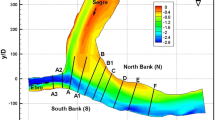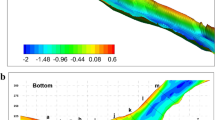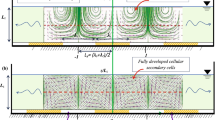Abstract
The effects of planform geometry and momentum flux ratio on thermal mixing at a stream confluence with concordant bed morphology are investigated based on numerical simulations that can capture the dynamics of large-scale turbulence. In two simulations, the bathymetry and asymmetrical planform geometry are obtained from field experiments and the momentum flux ratio is set at values of one and four. These two conditions provide the basis for studying differences in thermal mixing processes at this confluence when the wake mode and the Kelvin–Helmholtz mode dominate the development of coherent structures within the mixing interface (MI). The effects of channel curvature and angle between the two incoming streams on thermal mixing processes are investigated based on simulations conducted with modified planform geometries. Two additional simulations are conducted for the case where the upstream channels are parallel but not aligned with the downstream channel and for the zero-curvature case where the upstream channels are parallel and aligned with the downstream channel. The simulations highlight the influence of large-scale coherent structures within the MI and of streamwise-oriented vortical (SOV) cells on thermal mixing processes within the confluence hydrodynamics zone. Simulation results demonstrate the critical role played by the SOV cells in promoting large-scale thermal mixing for cases when such cells form in the immediate vicinity of the MI and in modifying the shape of the thermal MI within cross sections of the downstream channel—predictions consistent with empirical measurements of thermal mixing at the confluence. The set of numerical simulations reveal that the degree of thermal mixing occurring within the confluence hydrodynamic zone varies dramatically with planform geometry and incoming flow conditions. In some cases thermal mixing at the downstream end of the confluence hydrodynamic zone is limited to the MI and its immediate vicinity, whereas in others substantial thermal mixing has occurred over most of the cross-sectional area of the flow. Overall, the simulations highlight the flow conditions and the controls of these conditions that influence mixing within the immediate vicinity of a confluence.












Similar content being viewed by others
References
Arbat-Bofill M, Palau A, Sanchez-Junni M, Castellet EB, Ninerola D, Dolz J (2014) Hydrodynamics of Ribarroja reservoir (Ebro River, Spain): water temperature, water velocities and water age. In: Proceedings of the RiverFlow 2014 international conference on fluvial hydraulics, Lausanne, Switzerland, Ed. A. Schleiss, Taylor and Francis, London, UK
Ashmore PE, Ferguson RI, Prestegaard KL, Ashworth PJ, Paola C (1992) Secondary flow in anabranch confluences of a braided, gravel-bed stream. Earth Surf Process Landf 17:299–311
Babarutsi S, Chu VH (1998) Modeling transverse mixing layer in shallow open-channel flows. J Hydraul Eng 124:718–727
Best JL (1988) Sediment transport and bed morphology at river channel confluences. Sedimentology 35:481–498
Biron PM, Lane SN (2008) Modelling hydraulics and sediment transport at river confluences. In: Rice SP, Roy AG, Rhoads B (eds) River confluences, tributaries and the fluvial network. Wiley, Chichester, pp 17–43
Biron PM, Ramamurthy A, Han S (2004) Three dimensional numerical modeling of mixing at river confluences. J Hydraul Eng 130:243–253
Bouchez J, Lajeunesse E, Gaillardet J, France Lanord C, Dutra Maia P, Maurice L (2010) Turbulent mixing in the Amazon River: the isotopic memory of confluences. Earth Planet Sci Lett 290:37–43
Bradbrook KF, Lane SN, Richards KS, Biron PM, Roy AG (2001) Role of bed discordance at asymmetrical river confluences. J Hydraul Eng 127:351–368
Bradbrook KF, Lane SN, Richards KS, Biron PM, Roy AG (2000) Large Eddy Simulation of periodic flow characteristics at river channel confluences. J Hydraul Res 38(3):207–215
Bradbrook KF, Lane SN, Richards KS (1998) Investigation of controls on secondary circulation in a simple confluence geometry using a three-dimensional model. Hydrol Process 12:1371–1396
Chang KS, Constantinescu G, Park SO (2007) Assessment of predictive capabilities of detached eddy simulation to simulate flow and mass transport past open cavities. ASME J Fluids Eng 129(11):1372–1383
Constantinescu G (2014) LE of shallow mixing interfaces: a review. Environ Fluid Mech 14:971–996. doi:10.1007/s10652-013-9303-6
Constantinescu GS, Pasinato H, Wang YQ, Forsythe JR, Squires KD (2002) Numerical investigations of flow past a prolate spheroid. J Fluids Eng ASME 124(4):904–910
Constantinescu G, Chapelet MC, Squires KD (2003) Turbulence modeling applied to flow over a sphere. AIAA J 41(9):1733–1743
Constantinescu GS, Squires KD (2004) LES and DES investigations of turbulent flow over a sphere at Re = 10,000. Flow Turbul Combust 70:267–298
Constantinescu GS, Miyawaki S, Rhoads B, Sukhodolov A, Kirkil G (2011) Structure of turbulent flow at a river confluence with a momentum and velocity ratios close to 1: insight from an eddy-resolving numerical simulation. Water Resour Res 47:W05507. doi:10.1029/2010WR010018
Constantinescu G, Koken M, Zeng J (2011) The structure of turbulent flow in an open channel bend of strong curvature with deformed bed: insight provided by an eddy resolving numerical simulation. Water Resour Res 47:W05515. doi:10.1029/2010WR010114
Constantinescu G, Miyawaki S, Rhoads B, Sukhodolov A (2012) Numerical analysis of the effect of momentum ratio on the dynamics and sediment entrainment capacity of coherent flow structures at a stream confluence. J Geophys Res Earth Surf 117:F04028. doi:10.1029/2012JF002452
Constantinescu G, Kashyap S, Tokyay T, Rennie CD, Townsend RD (2013) Hydrodynamics processes and sediment erosion mechanisms in an open channel bend of strong curvature with deformed bathymetry. J Geophys Res Earth Surf 118:480–496. doi:10.1002/jgrf.20042
Constantinescu G, Miyawaki S, Rhoads B, Sukhodolov A (2014) Numerical evaluation of the effects of planform geometry and inflow conditions on flow, turbulence structure, and bed shear velocity at a stream confluence with a concordant bed. J Geophys Res Earth Surf 119:2079–2097. doi:10.1002/2014JF003244
Frias C, Abad JD (2013) Large eddy simulation (LES) for superimposed bedforms in fluvial channels. Water Resour Res 49:6548–6560. doi:10.1002/wrcr.20456
Gaudet JM, Roy AG (1995) Effect of bed morphology on flow mixing length at river confluences. Nature 373:138–139
Guneralp I, Abad JD, Zolezzi G, Hooke J (2012) Advances and challenges in meandering channels research. Geomorphology 163–164:1–9
Gutierrez R, Abad JD (2014) On the analysis of the medium term planform dynamics of meandering rivers. Water Resour Res. doi:10.1002/2012WR013358
Hunt JCR, Wary AA, Moin P (1988) Eddies, stream, and convergence zones in turbulent flows. In: Proceedings of the 1998 summer program. Center for Turbulence Research, Stanford, CA, 1988, pp 193–208
Keylock CJ, Constantinescu G, Hardy RJ (2012) The application of computational fluid dynamics to natural river channels: eddy resolving versus mean flow approaches. Geomorphology 179:1–20. doi:10.1016/j.geomorph.2012.09.006
Kiffney PM, Greene C, Hall JE, Davies J (2006) Tributary streams create spatial discontinuities in habitat, biological productivity and diversity in mainstem rivers. Can J Fish Aquat Sci 63:2518–2530
Kirkil G, Constantinescu SG (2008) A numerical study of shallow mixing layers between parallel streams. In: 2nd international symposium on shallow flows, Hong Kong, December 2008
Kirkil G, Constantinescu SG (2009) A numerical study of vertical non-uniformity of flow and mass exchange processes in a shallow turbulent mixing layer. In: 6th international symposium on turbulence, heat and mass transfer, Rome, Italy, September 2009
Kirkil G, Constantinescu G, Ettema R (2009) DES investigation of turbulence and sediment transport at a circular pier with scour hole. J Hydraul Eng 135(11):888–901. doi:10.1061/(ASCE)HY.1943-7900.0000101
Kirkil G, Constantinescu G (2015) Effects of cylinder Reynolds number on the turbulent horseshoe vortex system and near wake of a surface-mounted circular cylinder. Phys Fluids 27:075102. doi:10.1063/1.4923063
Knispel S, Castella E (2003) Disruption of a longitudinal pattern in environmental factors and benthic fauna by a glacial tributary. Freshw Biol 48:604–618
Koken M, Constantinescu G (2009) An investigation of the dynamics of coherent structures in a turbulent channel flow with a vertical sidewall obstruction. Phys Fluids 21:085104. doi:10.1063/1.3207859
Koken M, Constantinescu G, Blanckaert K (2013) Hydrodynamic processes, sediment erosion mechanisms, and Reynolds-number-induced scale effects in an open channel bend of strong curvature with flat bathymetry. J Geophys Res Earth Surf 118:2308–2324. doi:10.1002/2013JF002760
Laizet S, Lardeau S, Lamballais E (2010) Direct numerical simulation of a mixing-layer downstream a thick splitter plate. Phys Fluids 22:015104
Laraque A, Guyot JL, Filizola N (2009) Mixing processes in the Amazon River at the confluences of the Negro and Solimnoes rivers, Encontro das Aquas, Manaus, Brasil. Hydrol Process 23:3131–3140
Leite Ribeiro M, Blanckaert K, Roy AG, Schleiss AJ (2012) Flow and sediment dynamics in channel confluences. J Geophys Res 117:F01035. doi:10.1029/2011JF002171
Lewis QW, Rhoads B (2015) Rates and patterns of thermal mixing at a small stream confluence under variable incoming flow conditions. Hydrol Process. doi:10.1002/hyp10496
Liou WW (1994) Linear instability of curved free shear layers. Phys Fluids 6(2):541–549
Lyubimova T, Lepikhin A, Konovalov V, Parshakova Y, Tiunov A (2014) Formation of the density currents in the zone of confluence of two rivers. J Hydrol 508:328–342
Mackay JR (1970) Lateral mixing of the Liard and Mackenzie rivers downstream form their confluence. Can J Earth Sci 7(1):111–124
Marion A, Zaramella M (2006) Effects of velocity gradients and secondary flow on the dispersion of solutes in curved channels. J Hydraul Eng ASCE 132(12):1295–1302
Paola C (1997) When streams collide. Nature 387:232–233
Plesniak MW, Mehta RD, Johnson J (1996) Curved two-stream turbulent mixing layers revised. Exp Thermal Fluid Sci 13:190–205
Prats J, Armengol J, Marcé R, Sánchez-Juny M, Dolz J (2010) Dams and reservoirs in the lower Ebro River and its effects on the river thermal cycle, Hdb. Envion Chem 13:77–95
Ramon CL, Hoyer AB, Armengol J, Dolz J, Rueda FJ (2013) Mixing and circulation at the confluence of two rivers entering a meandering reservoir. Water Resour Res 49:1429–1445
Rathbun RE, Rostad CE (2004) Lateral mixing in the Mississippi River below the confluence with the Ohio River. Water Resour Res 40:W05207. doi:10.1029/2003WR002381
Rice S (1998) Which tributaries disrupt downstream fining along gravel-bed rivers? Geomorphology 22:39–56
Rice SP, Kiffney P, Greene C, Pess GR (2008) The ecological importance of tributaries and confluences. In: Rice SP, Roy AG, Rhoads B (eds) River confluences, tributaries and the fluvial network. Wiley, Chichester, pp 17–32
Riley JD, Rhoads B, Parsons DR, Johnson KK (2015) Influence of junction angle on three-dimensional flow structure and bed morphology at confluent meander bends during different hydrological conditions. Earth Surf Proc Land 40:252–271
Rhoads BL (1996) Mean structure of transport-effective flows at an asymmetrical confluence when the main stream is dominant. In: Ashworth PJ, Best JL, Bennett SL, McLelland SJ (eds) Coherent flow structures in open channels. Willey, New York, pp 491–517
Rhoads BL, Kenworthy ST (1995) Flow structure at an asymmetrical stream confluence. Geomorphology 11:273–293
Rhoads BL, Kenworthy ST (1998) Time averaged flow structure in the central region of a stream confluence. Earth Surf Proc Land 23:171–191
Rhoads BL, Sukhodolov AN (2001) Field investigation of three-dimensional flow structure at stream confluences: 1. Thermal mixing and time-averaged velocities. Water Resour Res 37(9):2393–2410
Rhoads BL, Sukhodolov AN (2004) Spatial and temporal structure of shear layer turbulence at a river confluence. Water Resour Res 40:W06304. doi:10.1029/2003WR002811
Rhoads BL, Sukhodolov AN (2008) Lateral momentum flux and spatial evolution of flow within a confluence mixing interface. Water Resour Res 44:WR08440. doi:10.1029/2007WR006634
Rodi W, Constantinescu G, Stoesser T (2013) Large eddy simulation in hydraulics IAHR Monograph. CRC Press, Taylor & Francis Group. ISBN-10: 1138000247
Sandham ND, Sandberg RD (2009) Direct numerical simulation of the early development of a turbulent mixing layer downstream of a splitter plate. J Turbul 10:1–17
Spalart PR, Allmaras SR (1994) A one-equation turbulence model for aerodynamic flows. La Recherche Aerospatiale 1:5–21
Spalart P (2009) Detached eddy simulation. Annu Rev Fluid Mech 41:181–202
Sukhdolov AN, Rhoads BL (2001) Field investigation of three-dimensional flow structure at stream confluences: 2. Turbulence. Water Resour Res 37:2411–2424
Winant CD, Browand FK (1974) Vortex pairing: the mechanism of turbulent mixing layer growth at moderate Reynolds numbers. J Fluid Mech 63:237–255
Wipfli M, Gregovich D (2002) Export of invertebrates and detritus from fishless headwater streams in southeastern Alaska: implications for downstream salmonid problem. Freshw Biol 47:957–970
Yalin MS, da Silva AMF (2001) Fluvial processes. Kluwer (IAHR) Monograph, Delft. ISBN 90-805649-2-3
Acknowledgments
The authors would like to thank the Transportation Research and Analysis Computing Center (TRACC) at the Argonne National Laboratory and the National High-Performance Computing Center in Taiwan (NHPC) for providing substantial computing time. Part of this work was supported by the National Science Foundation under Grant GSS1359836. Any opinions, findings or recommendations expressed herein are those of the authors and do not necessarily reflect the views of the National Science Foundation
Author information
Authors and Affiliations
Corresponding author
Rights and permissions
About this article
Cite this article
Constantinescu, G., Miyawaki, S., Rhoads, B. et al. Influence of planform geometry and momentum ratio on thermal mixing at a stream confluence with a concordant bed. Environ Fluid Mech 16, 845–873 (2016). https://doi.org/10.1007/s10652-016-9457-0
Received:
Accepted:
Published:
Issue Date:
DOI: https://doi.org/10.1007/s10652-016-9457-0




